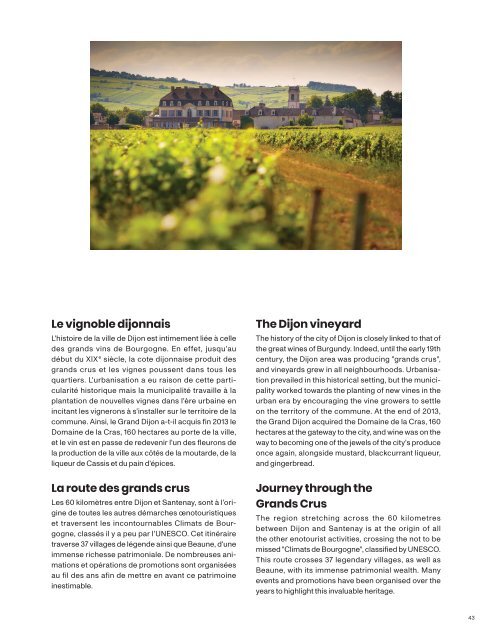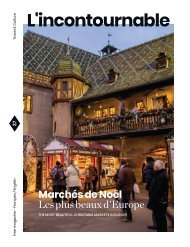L'incontournable N°36
L’incontournable Magazine - Travel and Culture - Bilingual ( En & Fr ) Free magazine available in France, Belgium and International Transportation Networks (Thalys, Eurostar, Rhonexpress...) www.lincontournable-magazine.fr
L’incontournable Magazine - Travel and Culture - Bilingual ( En & Fr )
Free magazine available in France, Belgium and International Transportation Networks (Thalys, Eurostar, Rhonexpress...)
www.lincontournable-magazine.fr
Create successful ePaper yourself
Turn your PDF publications into a flip-book with our unique Google optimized e-Paper software.
Le vignoble dijonnais<br />
L'histoire de la ville de Dijon est intimement liée à celle<br />
des grands vins de Bourgogne. En effet, jusqu'au<br />
début du XIX e siècle, la cote dijonnaise produit des<br />
grands crus et les vignes poussent dans tous les<br />
quartiers. L'urbanisation a eu raison de cette particularité<br />
historique mais la municipalité travaille à la<br />
plantation de nouvelles vignes dans l'ère urbaine en<br />
incitant les vignerons à s'installer sur le territoire de la<br />
commune. Ainsi, le Grand Dijon a-t-il acquis fin 2013 le<br />
Domaine de la Cras, 160 hectares au porte de la ville,<br />
et le vin est en passe de redevenir l'un des fleurons de<br />
la production de la ville aux côtés de la moutarde, de la<br />
liqueur de Cassis et du pain d'épices.<br />
La route des grands crus<br />
Les 60 kilomètres entre Dijon et Santenay, sont à l'origine<br />
de toutes les autres démarches œnotouristiques<br />
et traversent les incontournables Climats de Bourgogne,<br />
classés il y a peu par l'UNESCO. Cet itinéraire<br />
traverse 37 villages de légende ainsi que Beaune, d'une<br />
immense richesse patrimoniale. De nombreuses animations<br />
et opérations de promotions sont organisées<br />
au fil des ans afin de mettre en avant ce patrimoine<br />
inestimable.<br />
The Dijon vineyard<br />
The history of the city of Dijon is closely linked to that of<br />
the great wines of Burgundy. Indeed, until the early 19th<br />
century, the Dijon area was producing "grands crus",<br />
and vineyards grew in all neighbourhoods. Urbanisation<br />
prevailed in this historical setting, but the municipality<br />
worked towards the planting of new vines in the<br />
urban era by encouraging the vine growers to settle<br />
on the territory of the commune. At the end of 2013,<br />
the Grand Dijon acquired the Domaine de la Cras, 160<br />
hectares at the gateway to the city, and wine was on the<br />
way to becoming one of the jewels of the city's produce<br />
once again, alongside mustard, blackcurrant liqueur,<br />
and gingerbread.<br />
Journey through the<br />
Grands Crus<br />
The region stretching across the 60 kilometres<br />
between Dijon and Santenay is at the origin of all<br />
the other enotourist activities, crossing the not to be<br />
missed "Climats de Bourgogne", classified by UNESCO.<br />
This route crosses 37 legendary villages, as well as<br />
Beaune, with its immense patrimonial wealth. Many<br />
events and promotions have been organised over the<br />
years to highlight this invaluable heritage.<br />
43




